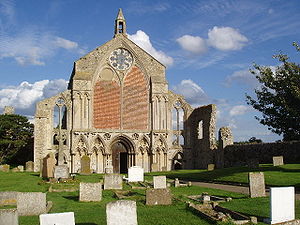- Dissolution of the Lesser Monasteries Act
-
The Act for the Dissolution of the Lesser Monasteries – (citation 27 Henry VIII. c. 28) was an Act of the English Reformation Parliament of 1535/36, the beginning of the legal process by which King Henry VIII set about the Dissolution of the Monasteries. It is also referred to as the Suppression of Religious Houses Act 1535, as it was enacted in February 1535 Old Style.
Contents
Background
From the 14th century onwards, several popes had granted licenses for the suppression of religious houses in England.[1]
The breakdown of relations between Henry VIII and the Church in Rome, prompted by his marriage to Anne Boleyn, resulted in the Statute in Restraint of Appeals of 1533, forbidding all appeals to the Pope in Rome on religious or other matters.[2] Pope Clement VII responded by announcing Henry's provisional excommunication, and the hostility between the king and the pope escalated.[3] In the words of John Burton's Monasticon Eboracense (1758) –
The casting off the Pope's Supremacy, and the Monks being looked on only as a sort of half-subjects, ever ready to join any foreign power, which should invade the nation, whilst the King [Henry VIII] was excommunicated by the Pope... together with the [former] alienation of the lesser houses, were urged for seizing the rest; to which the King's want of a large supply, and the people's willingness to save their own pockets, greatly contributed; and accordingly, a motion shortly after was made in Parliament, that, to support the King's state, and supply his wants, all the religious houses might be conferred upon the Crown, which were not able to expend clearly above 200l. per annum. This Act passed about March, A. D. 1535.[1]Parliament met on 4 February 1535/36 and received a digest of the report Valor Ecclesiasticus, a visitation of the monasteries of England commissioned by the King, and soon after passed the Act.[4]
The Act applied only to lesser houses "which have not in lands, tenements, rents, tithes, portions, and other hereditaments, above the clear yearly value of two hundred pounds", attacking such houses as dens of iniquity and proposing that those in them should be "committed to great and honourable monasteries of religion" and "compelled to live religiously".[5]
Preamble
The preamble of the Act states -
“ FORASMUCH as manifest sin, vicious, carnal and abominable living is daily used and committed among the little and small abbeys, priories, and other religious houses of monks, canons, and nuns, where the congregation of such religious persons is under the number of twelve persons, whereby the governors of such religious houses, and their convent, spoil, destroy, consume, and utterly waste, as well their churches, monasteries, priories, principal houses, farms, granges, lands, tenements, and hereditaments, as the ornaments of their churches, and their goods and chattels, to the high displeasure of Almighty God, slander of good religion, and to the great infamy of the king's highness and the realm, if redress should not be had thereof. And albeit that many continual visitations hath been heretofore had, by the space of two hundred years and more, for an honest and charitable reformation of such unthrifty, carnal, and abominable living, yet nevertheless little or none amendment is hitherto had, but their vicious living shamelessly increases and augments, and by a cursed custom so rooted and infected, that a great multitude of the religious persons in such small houses do rather choose to rove abroad in apostasy, than to conform themselves to the observation of good religion; so that without such small houses be utterly suppressed, and the religious persons therein committed to great and honourable monasteries of religion in this realm, where they may be compelled to live religiously, for reformation of their lives, there can else be no redress nor reformation in that behalf.[5] ” Effect
The main effect of the Act was to expropriate the lesser religious houses to the King, who (in the words of the Act) "shall have to him and to his heirs all and singular such monasteries, abbeys, and priories, which at any time within one year next before the making of this Act have been given and granted to his majesty by any abbot, prior, abbess, or prioress, under their convent seals, or that otherwise have been suppressed or dissolved... to have and to hold all and singular the premises, with all their rights, profits, jurisdictions, and commodities, unto the king's majesty, and his heirs and assigns for ever, to do and use therewith his and their own wills, to the pleasure of Almighty God, and to the honour and profit of this realm".[5]
This section includes a retrospective effect, regularizing suppressions of houses which had already taken place.
See also
- English Reformation
- List of monasteries dissolved by Henry VIII of England
- Second Act of Dissolution
Notes
- ^ a b John Burton, MD, Monasticon Eboracense (York: 1758), quoted in The Monthly Review p 275 at books.google.com
- ^ Act in Restraint of Appeals, full text at freeuk.net
- ^ J. J. Scarisbrick, Henry VIII (1972), pp. 414–18
- ^ An act for the Dissolution of the lesser Monasteries at tudorplace.com.ar
- ^ a b c Act for the Dissolution of the Lesser Monasteries, full text at freeuk.net
Categories:- 1536 in law
- 1536 in England
- Acts of the Parliament of England concerning religion
- Dissolution of the Monasteries
Wikimedia Foundation. 2010.

